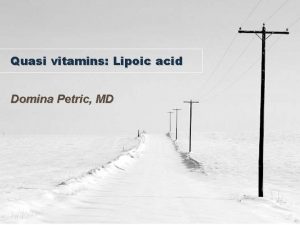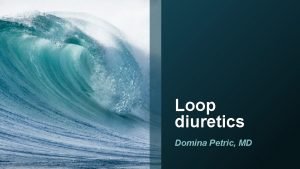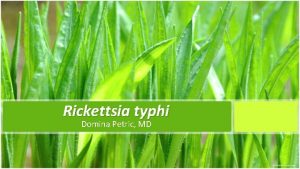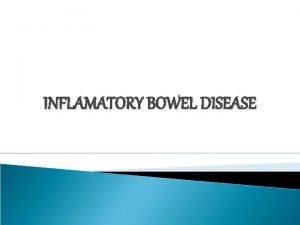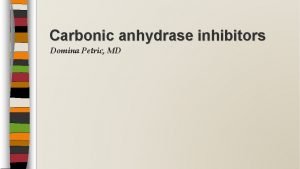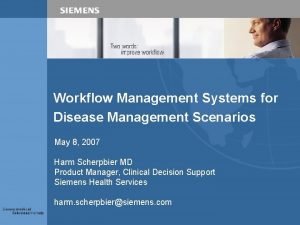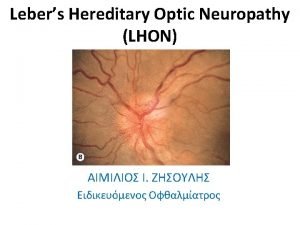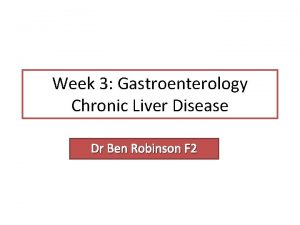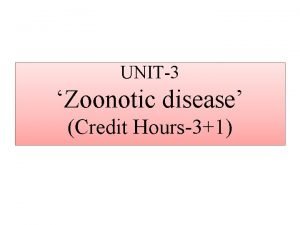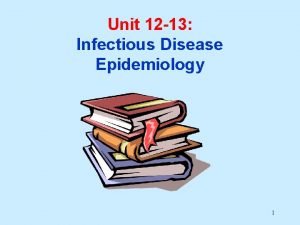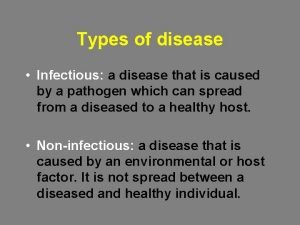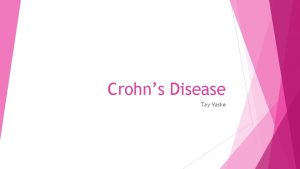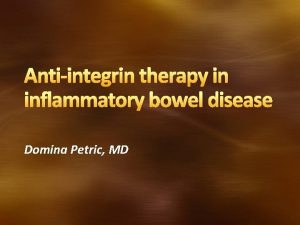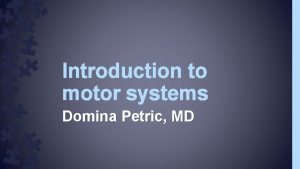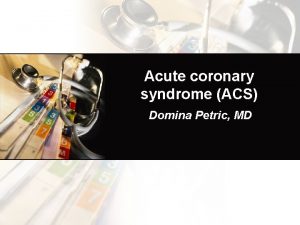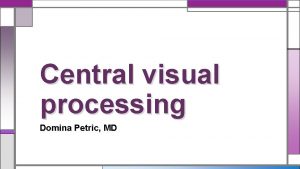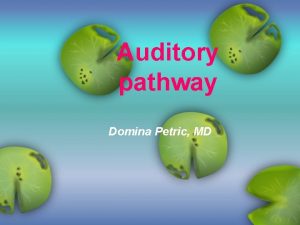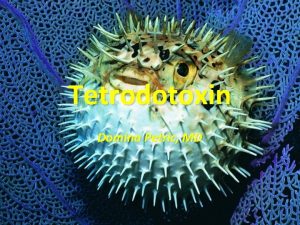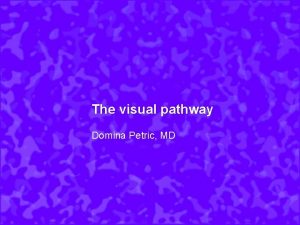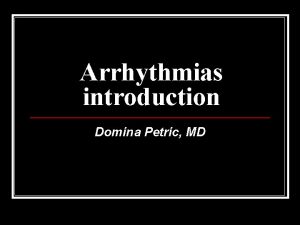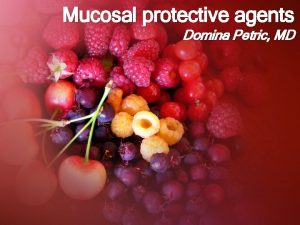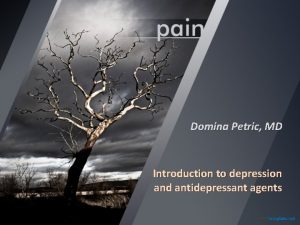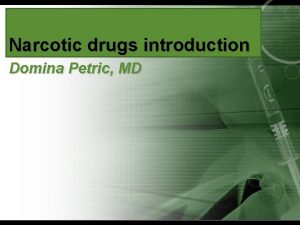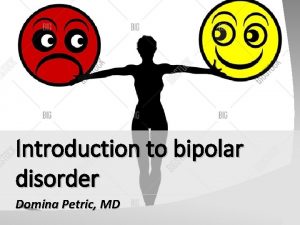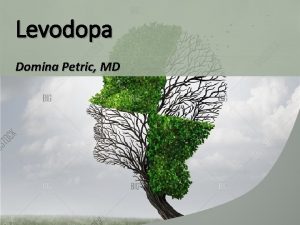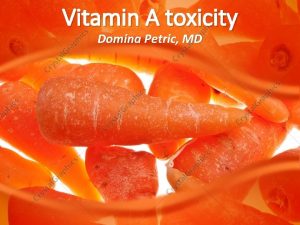Crohns disease Domina Petric MD Introduction Crohns disease


























- Slides: 26

Crohn´s disease Domina Petric, MD

Introduction Crohn´s disease is a chronic inflammatory gastrointestinal disease characterised by transmural granulomatous inflammation affecting any part of the gut from mouth to anus. There is unaffected bowel between areas of active disease: SKIP LESIONS.

Cause • • Cause is unknown. Environmental agents are implicated. Genetics: mutations of the NOD 2/CARD 15. Colon involvement goes with increased CARD 15 gene expression in macrophages and intestinal epithelial cells. • Dysregulated immune responses might be primary or secondary (infecting gut commensals like Mycobacterium avium para -TB). • E. coli adhesins, p 273, may play a role in developing Morbus Crohn.

Epidemiology • Prevalence is 0, 5 -1/1000. • More common in women. • Incidence is 5 -10/100000/year. • Presentation is mostly at age of 20 to 40 years. • Smoking increases risk 3 -4 times. • NSAID may exacerbate disease.

Symptoms • • • diarrhoea and urgency abdominal pain weight loss, failure to thrive fever malaise anorexia

Symptoms Patients can feel fine one minute, and deathly ill the next minute. Diarrhoea is usually very smelly.

Signs in the GI tract • aphthous ulcerations • abdominal tenderness or mass • perianal abscess, fistulae • skin tags • anal strictures

Extraintestinal signs clubbing skin, joint and eye problems

Skip lesions Source: Meddiction. com

Complications small bowel obstruction toxic dilatation (colonic diameter>6 cm) abscess formation (abdominal, pelvic, ischiorectal) fistulae (colovesical, colovaginal, perianal, enterocutaneous)

Complications rectal haemorrhage colon cancer fatty liver primary sclerosing cholangitis cholangiocarcinoma

Complications renal stones osteomalacia malnutrition amyloidosis

Blood tests Full blood count Erythrocyte sedimentation rate CRP Urea, creatinine and electrolytes INR, liver function tests Ferritin, TIBC, B 12, folate

Diagnostics Stool microbiology, faecal calprotectin Colonoscopy + rectal biopsy Small bowel enema Capsule endoscopy Barium enema MRI

Mild attack Symptomatic patient, but systemically well. Prednisolone 30 mg/d per os for 1 week, then 20 mg/d for 4 weeks. If symptoms resolve, prednisolone 5 mg every 2 -4 weeks. When parameters are normal, stop prednisolone.

Severe attacks Patient is systemically ill. Admit in the hospital for iv. steroids. Nil by mouth! Iv. infusion 1 L 0, 9% saline + 2 L dextrose-saline/24 hours + 20 mmol K+/L (less potassium in elderly).

Severe attacks • Hydrocortisone 100 mg/6 h iv. • Hydrocortisone 100 mg in 100 m. L 0, 9% saline/12 hours per rectum is effective treatment for rectal disease. • Metronidazole 400 mg/8 hours per os or 500 mg/8 hours iv. can be useful in perianal disease or superadded infection.

Severe attacks • Daily physical examination with full blood count, erythrocyte sedimentation rate, CRP, urea, creatinine and eletrolytes. • Plain abdominal X ray. • Consider need for blood transfusion and parenteral nutrition.

Severe attacks If the patient is improving after 5 days, transfer to oral prednisolone 40 mg/day. If the patient is not improving, INFLIXIMAB or ADALIMUMAB. In the case of severe abdominal pain, consider abdominal sepsis complicating Crohn´s disease.

MEDICATIONS FOR MORBUS CROHN

Azathioprine Dose is 2 -2, 5 mg/kg/day per os. It can be used as a steroid-sparing agent. It takes 6 -10 weeks for clinical improvement.

Sulfasalazine Although unproven efficacy, sulfasalazine is useful in Crohn´s disease, especially high-dose postoperatively in patients with ileal resection.

TNFα inhibitors • Infliximab and adalimumab can decrease disease activity because TNFα plays important role in pathogenesis of Crohn´s disease. • They counter neutrophil accumulation and granuloma formation, activate complement and cause cytotoxicity to CD 4+ T-cells.

Methotrexate 25 mg im. weekly for remission induction is enabling complete withdrawal from steroids in patients with refractory Crohn´s disease.

Nutrition Enteral nutrition is preferred (polymeric diet) over the total parenteral nutrition in exacerbations. Low residue diets help control Crohn´s activity.

Literature • Oxford Handbook of Clinical Medicine. Longmore M. Wilkinson I. B. Baldwin A. Elizabeth W. Ninth edition. • Meddiction. com • Wikipedia. org
 Quasi vitamin b
Quasi vitamin b Domina petric
Domina petric Domina severe
Domina severe Domina petric
Domina petric Md
Md Pseudomonopolar
Pseudomonopolar Domina tasks
Domina tasks Crohn's disease symptoms
Crohn's disease symptoms Crohns disese
Crohns disese Crohn's didease
Crohn's didease Jure petric
Jure petric Sveta lucija pjesma
Sveta lucija pjesma 8 atitudes vencedoras
8 atitudes vencedoras Quimestres
Quimestres Cada miembro domina una parcela determinada del proyecto
Cada miembro domina una parcela determinada del proyecto Carbonic anhydrase use
Carbonic anhydrase use Türkische domina
Türkische domina Casi indiretti
Casi indiretti Bharathi viswanathan
Bharathi viswanathan Body paragraph
Body paragraph Disease-specific workflows
Disease-specific workflows Leber disease
Leber disease Decompensated liver disease
Decompensated liver disease Prion disease symptoms
Prion disease symptoms Disease betekenis
Disease betekenis Factors that affect disease transmission
Factors that affect disease transmission Types of diseases
Types of diseases
